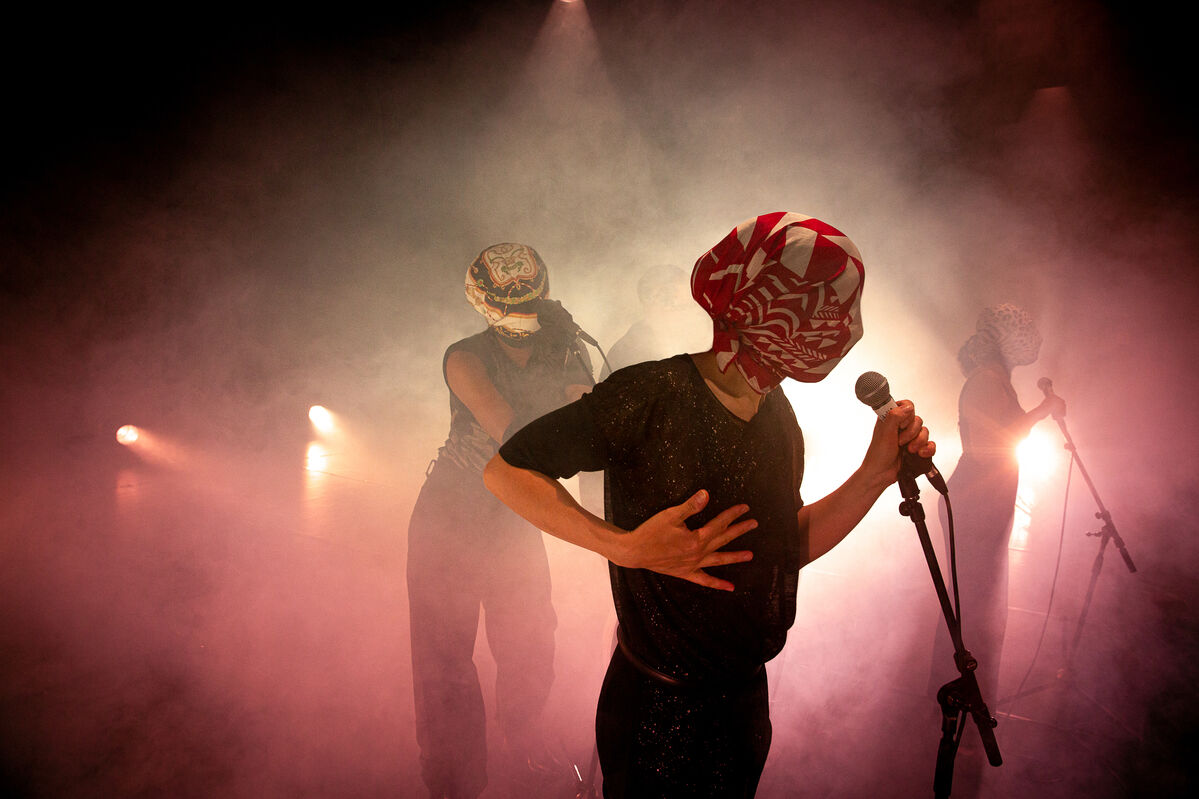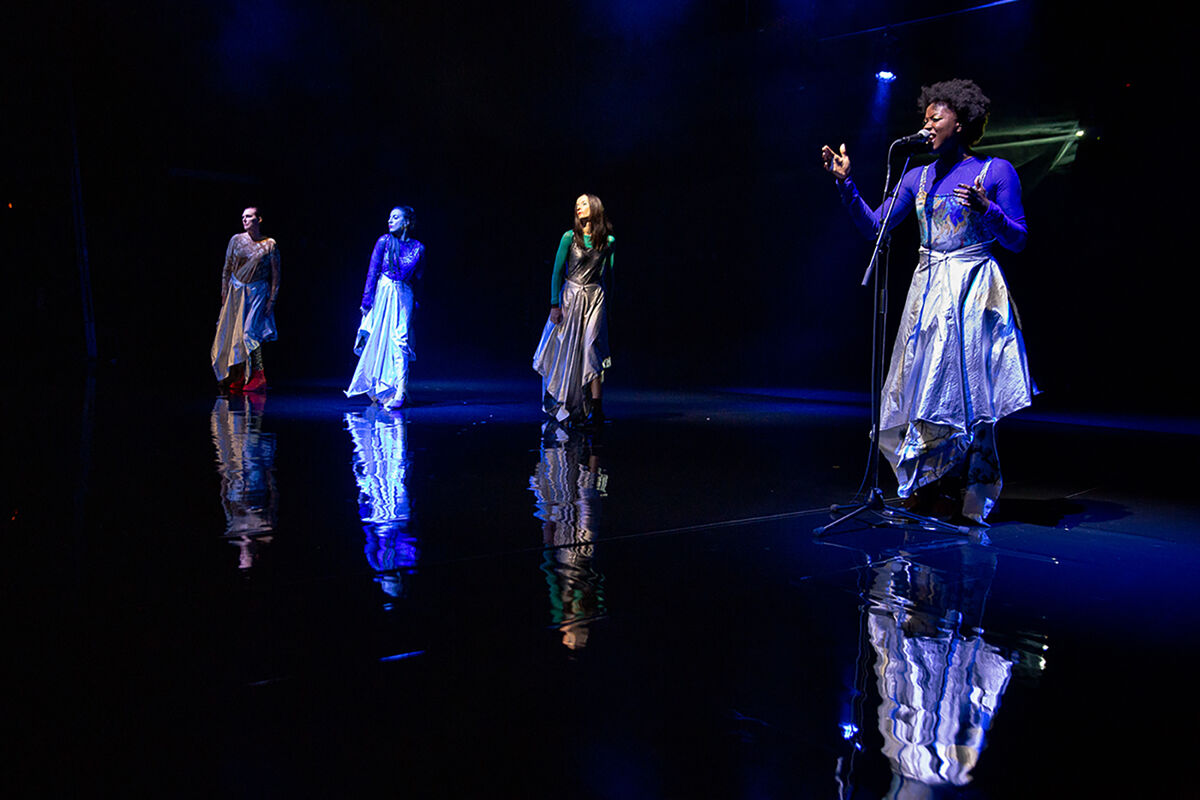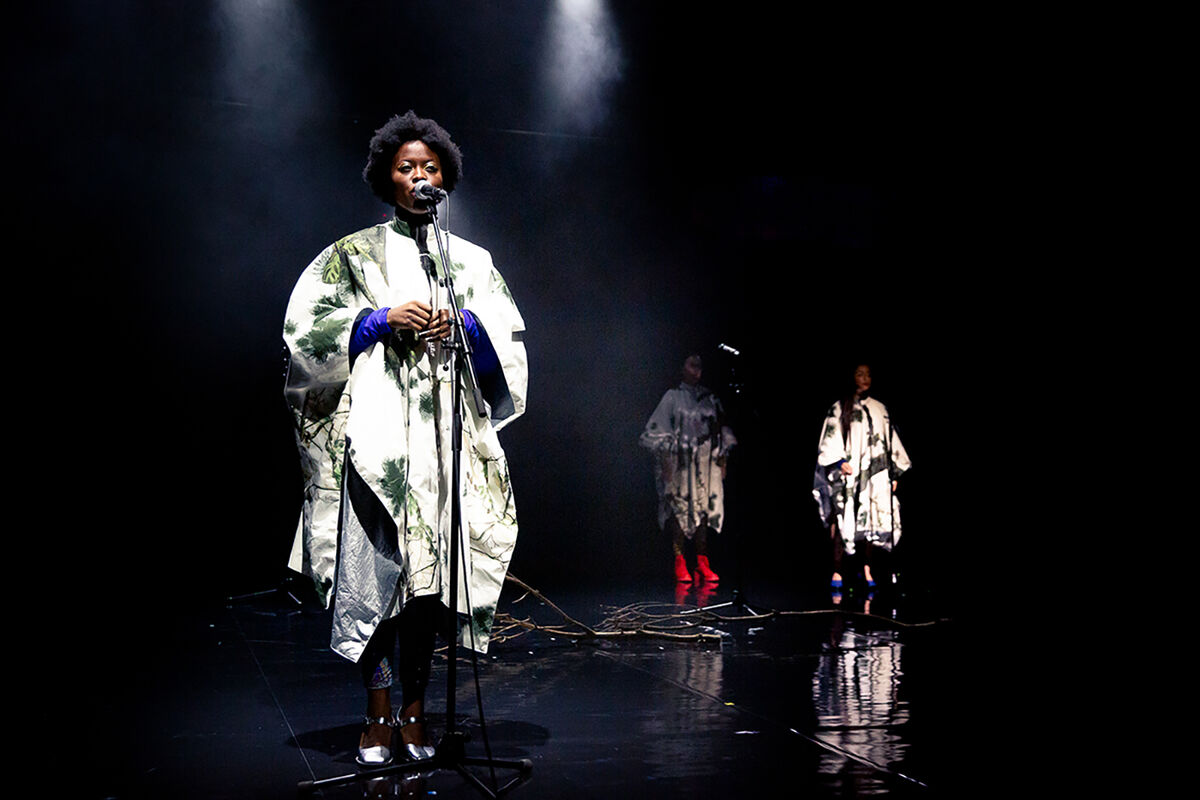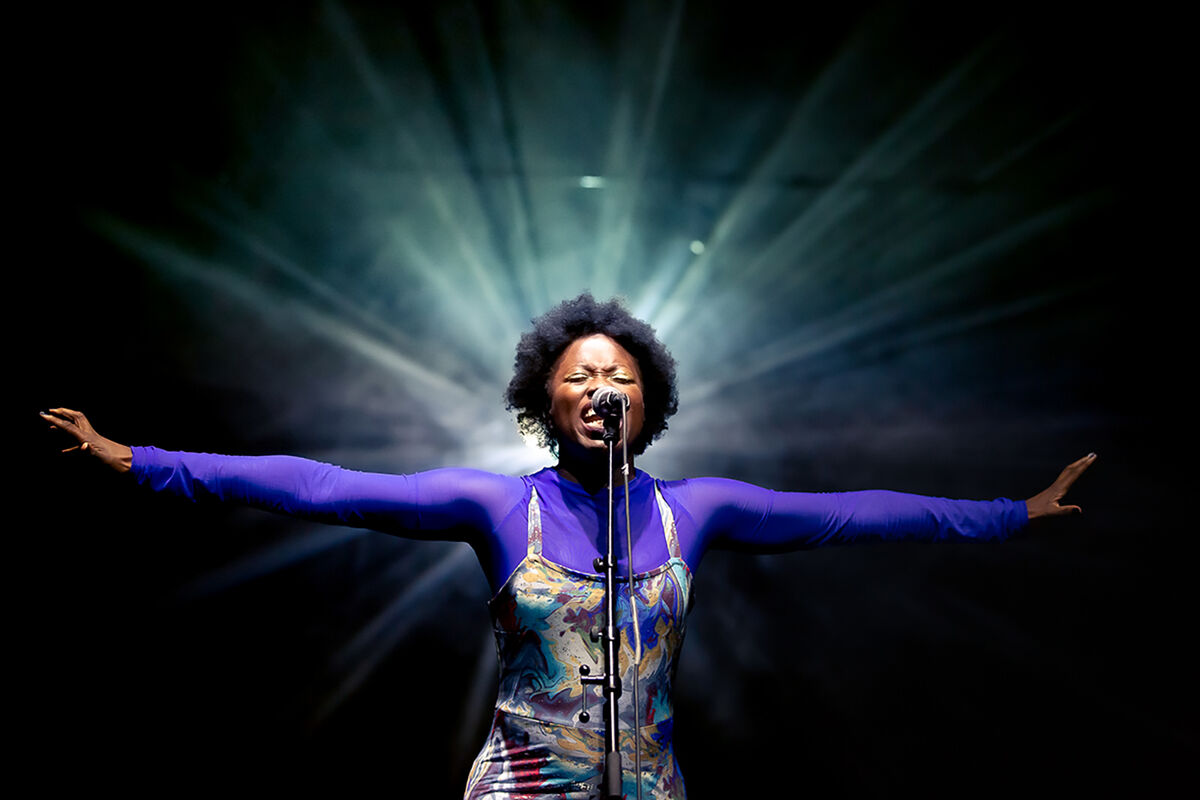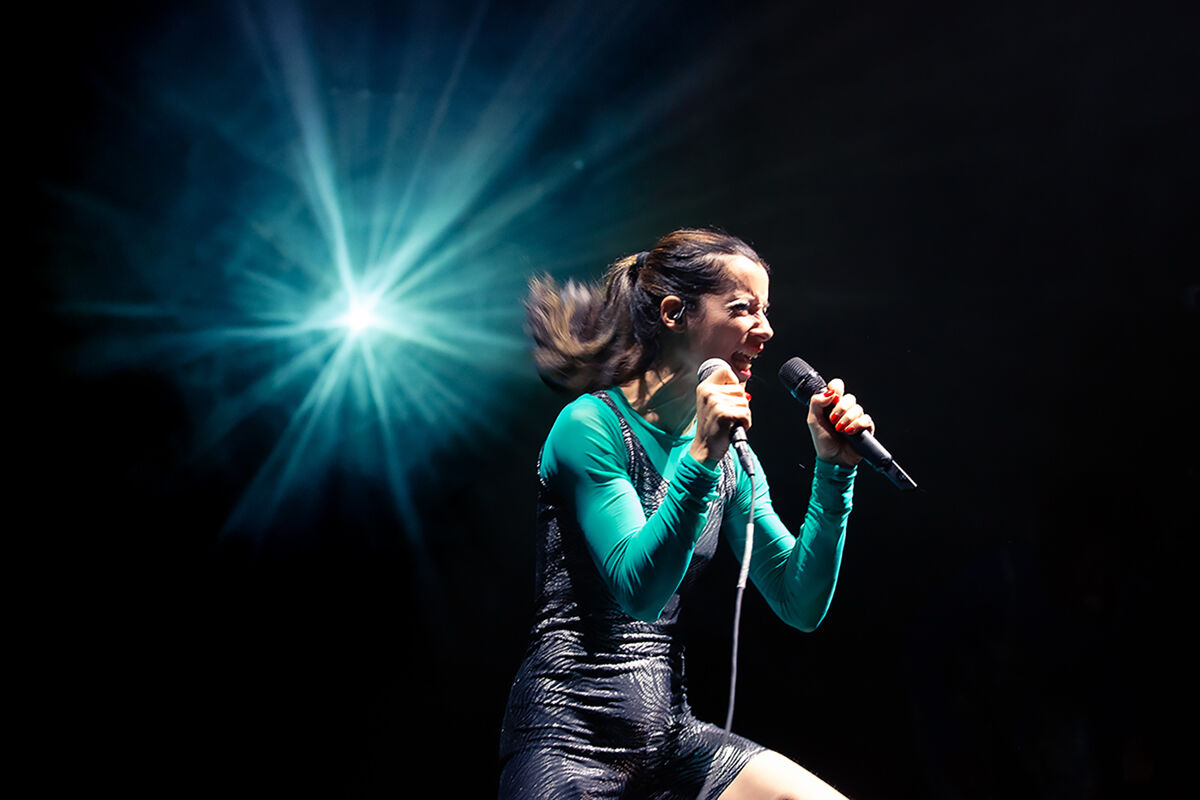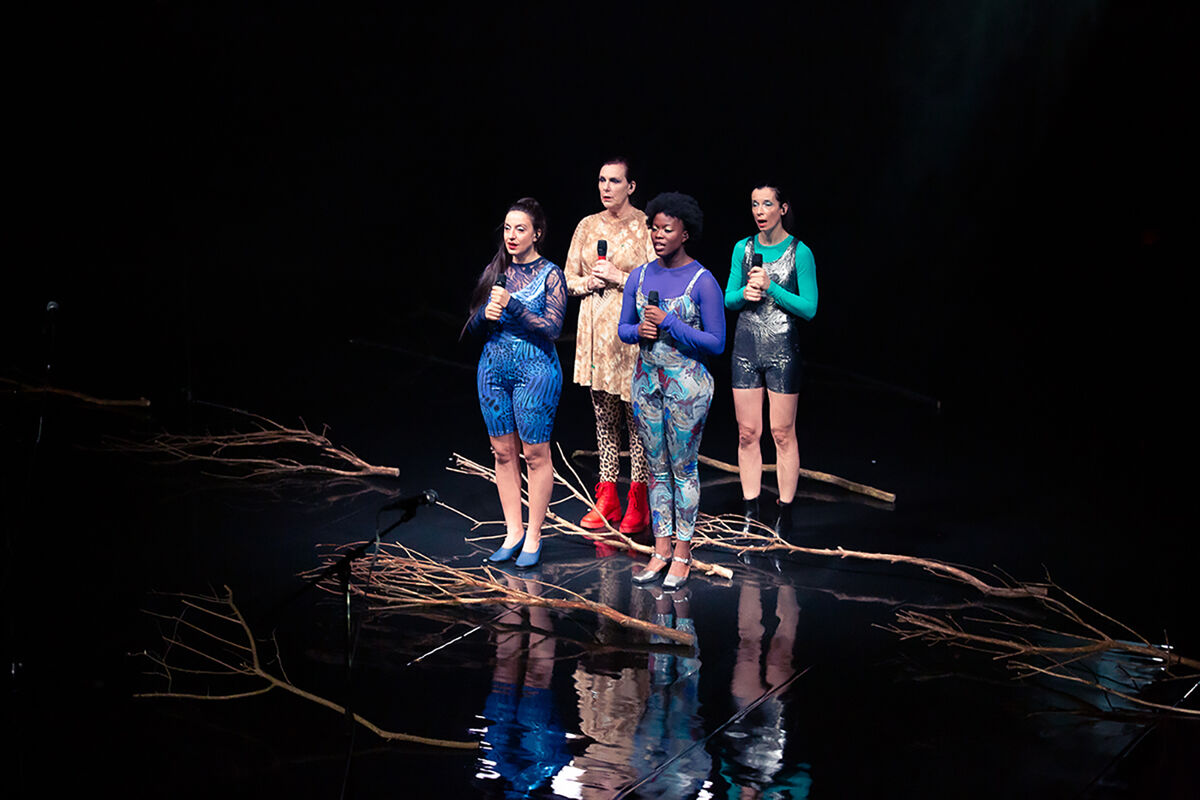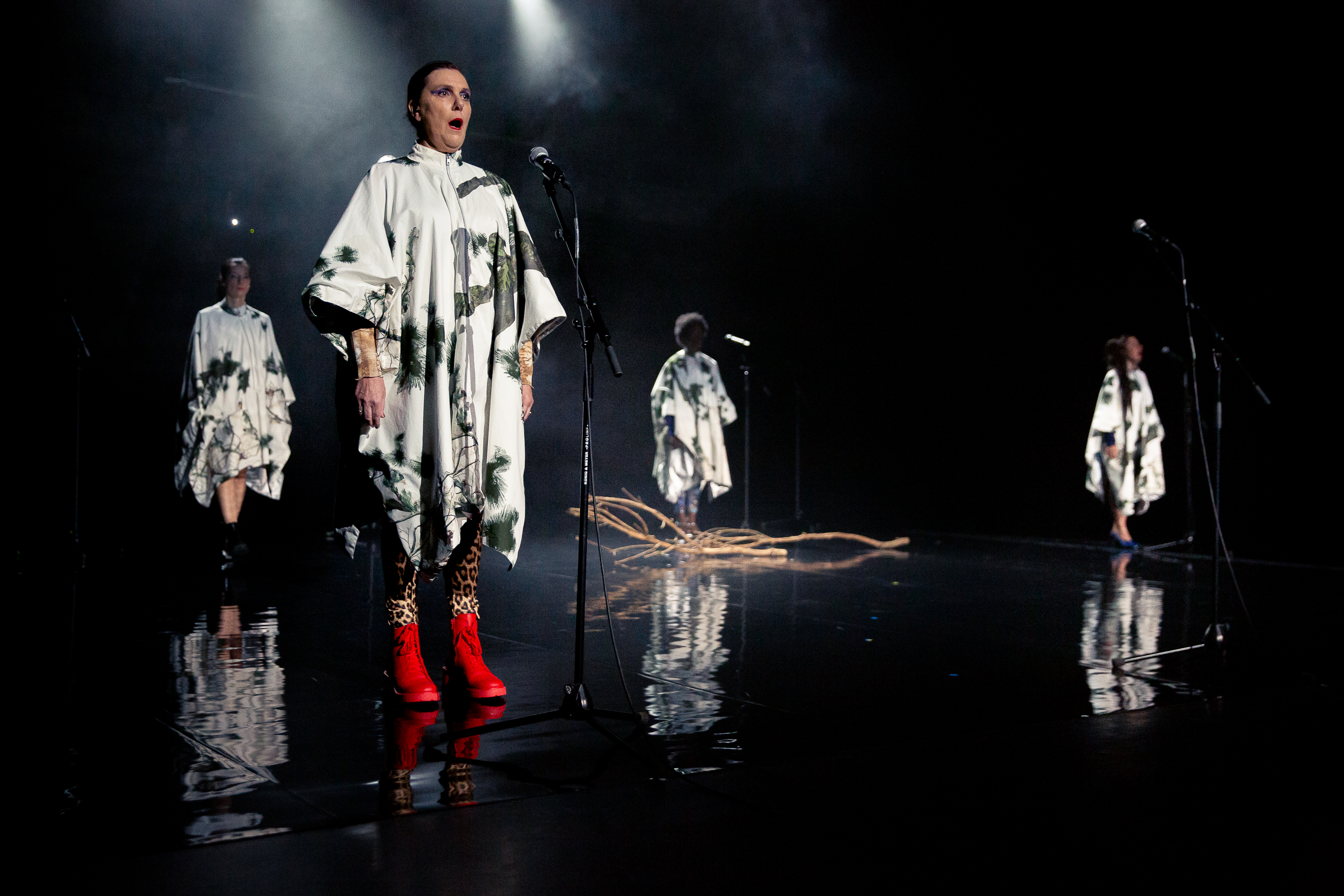 An infectious performance that never bores and flawlessly combines classical mythology and all-too-human contemporary stories
An infectious performance that never bores and flawlessly combines classical mythology and all-too-human contemporary storiesDemeter Calling (2021)
Concert performance with 4 women of different backgroundDemeter Calling is a concert performance in which an all-female cast from diverse backgrounds, including director Sanja Mitrović, channel voices of sisters dispersed across the gulfs of geography, ethnicity and culture.
'One day they will listen to me, a woman.'
Stories of women from different parts of the world are poetically interpreted and translated into songs which question the notion of motherhood as the sole focus of female identity. In the liminal space between a world which has already ended and another yet to begin, they are an unlikely girl band celebrating female strength, resilience and determination to create space for oneself, even among harsh hardships, injustices and hostilities imposed by society.
Inspired by a visit to Elefsina, the site of Eleusianian Mysteries through which the cult of Demeter and Persephone was celebrated in antiquity, Mitrović was moved to consider resonances of this ancient myth with the lives of women today. As if in a trance, Demeter Calling arrives in the form of a contemporary music ritual which continues to call for strength and wisdom in how to live one’s life to its full potential.
New original music by Belgrade-based composer Marija Balubdžić takes as inspiration female chants and rhythms from various Balkan regions, forging them into slivers of glistening electronic avant-pop, broadcast from somewhere decidedly off the radar, otherworldly and resistant to categorisation.
Cast And Credits
Concept, Text & Direction: Sanja Mitrović. Performance: Sanja Mitrović, Ana Naqe, Kathy Sey, Magda Ral Featuring Istok Liefooghe Mitrović, Wolf Segelstein. Dramaturgy: Sara Vanderieck. Original Music: Marija Balubdžić. Musical Arrangements: Marija Balubdžić & Siniša Mitrović. Choreography: Sanja Mitrović & Audrey Apers. Costume Design: Ivana Kličković. Set & Lighting: Design Giacomo Gorini. Sound Design: Johannes Bellinck, Patrick Van Neck. Assistant Director: Siniša Mitrović Assistant Director (Internship): Audrey Apers. Dramaturgical Advice: Gerardo Salinas. Set Design Advice: Laurent Liefooghe. Research: Tunde Adefioye. Production Manager: Robin Hectors. Saxophones: Grégoire Tirtiaux
Production: Stand Up Tall Productions. Coproduction: Perpodium, Kvs Uitvoerend Producent. Executive Production: Caravan Production. Residency: Kvs Koninklijke Vlaamse Schouwburg. With The Support Of The Flemish Authorities, Vlaamse Gemeenschapscommissie, De Taxshelter Maatregel Van De Belgische Federale Overheid In Samenwerking Met Casa Kafka Pictures
The Script Contains Quotes From Texts By Gloria Evangelina Anzaldúa, Berta Cáceres And Phia Ménard.
Press
A conversation with Sanja Mitrovic
KVS website (in English), 21.01.2022A Conversation With Sanja Mitrović
We meet with Sanja to get insight into the “making of” Demeter Calling and the inspiration behind it.
Demeter Calling has been defined in various ways: from theatre to opera to concert/concept performance. How do you perceive these or any other labels to define your work and how would you situate it in your oeuvre so far?
To a certain extent all these descriptions are useful reference points, but none captures the project completely. This fluidity is important to me as an artistic principle. In my previous practice I was also working with montage, combining elements from different creative disciplines – documentary and drama, moving image, performance and dance. So rather than some kind of a clean-cut, purist form or genre, my inclination is towards hybrid, “contaminated” forms as better equipped to speak to the messiness and complexity of the lived experience against the interminable march of history.
Previously I have been working with documents in different ways: staging personal stories of the performers, working with professionals and non-professionals, staging re- enactments, mixing reality and fiction. Demeter Calling is a step further in my research on how to present real life-based material on stage. Music became an important part in this process. I was interested in the relationship between music and document, in particular how to integrate music as a theatrical “tool” to translate documentary material. In the so-called documentary theatre the question tends to arise whether the story is being told authentically. The focus on music helps alleviate doubts about the relationship between the material and performers. Music acts as a connecting medium. The audience is able to feel it more directly than they would a story or a speech, and the performers are also able to dive into the narrative in a new way. Thanks to singing they can claim a new space of freedom where they are still themselves,
as well as part of the stories they embody. They no longer appropriate these voices like classical actors would; their bodies become “channels” for these voices to appear.From another perspective, Demeter Calling is also my attempt to find a meeting point between a classical text and contemporary stories. For the script I collected and interpreted contemporary stories of women from different parts of the world, some of whom I met and spoke with personally, others public figures from the research which was conducted as part of the process. They include environmental and human rights activists, mothers who lost their children due to political conflict and social inequality, as well as those who are unable to meet multiple expectations – of mothering, parenting, caregiving, nursing, homemaking – through which femininity is traditionally defined, patrolled and measured up against.
How did the process of collecting and selecting those women and their stories go?
During the research with dramaturge, writer and lecturer Tunde Adefioye, we looked for stories of women who had a particular relationship with their children, especially those that reflect the extremes of motherhood. We wanted to consider the personal relationship with a child in a broader socio-political context. We studied books and articles, various different sources, and tried to understand what stories found echoes in other stories. In this way we would discover connections while keeping geographical variety and a range of socio-political contexts in the profiles of women. On the other hand, we also had to think about what makes sense dramaturgically. So at a later stage I sat down with dramaturge Sara Vanderieck to narrow down the choices from this wealth of material. In the end, we used the myth of Demeter and her daughter Perspehone as the dramaturgical connecting thread in the piece.
From the beginning I was inspired by a visit to Elesfina in Greece, the site of Eleusinian Mysteries through which the cult of Demeter and Persephone was celebrated. The initiates of the cult were recruited from all walks of life, the secretive and elaborate rites they underwent aimed at, in words of one classical writer, gaining “the power not only to live happily, but also to die with a better hope." A solitary visit to the excavation site made me think of how this relates to lives of women today.
I was interested in contemporary voices and a tension between the classical myth and stories that are not far removed from us, for example an environmental activist, a woman who was diagnosed with postnatal depression, a mother who abandons her child in order to defend her husband’s honour, etc. I wanted to create a sense of timelessness interwoven with individual lives of women, the relationship between mother and child, and how they all question patriarchal interpretations of womanhood. In line with my ongoing interest in the use of music in theatrical context, at one point in the process I decided to translate these stories into a series of songs.
Eventually, Demeter Calling arrived in the form that could, perhaps, be described as a contemporary music ritual, still seeking answers on how to go through life with dignity and determination. It is almost a kind of a trance, suspended in a continual ebb and flow between imaginary rituals and a pop concert.
The story of Demeter is rooted in Greek mythology. In traditional Greek theatre we would expect to find a singing choir that would guide our emotions as spectators, define it even. In Balkan folklore we see a similar phenomenon where several women's voices are collected to sound as one. This pattern has been used successfully later in both pop and rock bands from the early '70s (think Abba or Yugoslavian rock bands). What do you find to be the strength in the united female voices and how did these classical and traditional forms of performance influence your choice in music and vocals?
Pop music articulates aspects of everyday life as a shared and often highly emotional experience. In theatre, this is reflected in the presence of various popular formats – from the choirs of Greek tragedy to opera, vaudeville, cabaret and American music theatre, as well as the influence of popular music on modernist avantgardes (for example, Brecht or Genetl).
Personally, I was always drawn to the vocal traditions of Balkan folklore and the collective aspect of this practice. It is something which was close to me since early childhood through my grandmother who was from Herzegovina. At the same time, pop music has always been a hugely formative influence for me, still plays an important part in my life, and for a long time I was waiting for an opportunity to make a project which might connect these two rich vernaculars. I also still often remember Serbia in the 1990s when pop music, dancing and partying served not only as an escapist route out of the suffocating reality of social collapse but also as a form of résistance to an oppressive regime.In Demeter Calling, the key was collaborating with composer Marija Balubdžić, who approached each narrative not only as a study in musical dramaturgy but as an opportunity for joyous experimentalism. As the starting point we decided to use elements of folk music from various Balkan regions, especially those which, like you say, emphasize the power of united female voiles. Subsequently Marija transformed them, often beyond recognition, into bursts of mesmerising electronic pop, like chart topping hits from another dimension. The intricate arrangements and vocal lines, the elaborate dynamic between choral singing, individual lead voices and backing vocals, reflect the Greek tragedy’s consideration of the relationship between private and public. While staking its territory on the cutting edge of contemporary, Marija’s score embodies the echoes of the ritual and the ceremonial which are central to the overall atmosphere and tone of the show. Initially, I also wanted to work with a female DJ in order to explore the relationship between live music performance and already existing recordings. In the end Marija collaborated with Siniša Mitrović, my brother and assistant director, on arrangements which brought the compositions to blossom into uncanny hybrids of dance, pop and experimental.
I mentioned how the show oscillates between more performative elements, which we thought of as a kind of invocation rituals, summoning the voices of women whose stories are told, and aesthetics of a pop concert with all its visual signifiers. For this aspect I was delighted to work again with Ivana Kličković on costume and Giacomo Gorini on set and lighting. With bold designs each of them propelled Demeter Calling into a dreamlike, hallucinatory state in which the music is embedded. Some of the elements are purposefully exaggerated, playing with the stereotypes of femininity, glamour and spectacle, while staying close to the territory of performance-oriented concerts, like those by artists such as CocoRosie, Björk, The Knife or Peaches.
Choreographic elements are treated similarly. They’re fairly reduced and simple, referencing the language of pop concert and music video, but still more prominent than in my previous work. Looking back and considering my background, which started from classical ballet as a child, to contemporary dance and physical theatre during my studies, I realise that perhaps it is no surprise that music and movement are present in Demeter Calling to such an extent. They have been present in my other works as well, but previously I did not use them systematically as the main methodology in the treatment of documentary material.
The women-only cast is an interesting starting point to rework the not-so-feminist myth of Demeter. Why choose this specific story?
You are right, the myth of Demeter and Persephone could be read through a misogynist lens, with women portrayed as subject to the will of powerful men, their rebellion merely serving to reinforce the patriarchal order and relationships of dominance. But, like most myths, we could look at it from a different angle. What was important to me in this story was female strength, solidarity and the refusal to simply accept the fate decided for them by others. Demeter firmly confronts the injustice she and her daughter have suffered, she takes radical action against it and, from the position of limited possibility, carves out a space of resolution, which is not ideal or world-changing but which sustains female agency in a male-dominated world.
In Demeter Calling we propose that Demeter and Persephone are not helpless victims or tragic heroines, but strong women who actively decide how to cope with the predicament they find themselves in. It is their decision to create seasons in order to mark periods when they are together and apart, to celebrate moments of reunion, and even to initiate human race
in the sacred rites of maintaining life on Earth through agriculture. They turn the situation of aggression and restriction into one of new possibilities. Similarly, the contemporary stories of women in the show are, for me, examples of resisting the roles imposed on them and reclaiming, from a state of exhaustion, breakdown and extreme emotional and existential upset, a space of potential rebirth and reinvention.Motherhood and suffering is used as an underlying theme in the myth of Demeter to explain the seasonality of nature. In the traditional gender stereotypes the woman's body has been synonymous to emotions and nature. How do women use their voice to interplay with these labels of womanhood?
It is pretty stereotypical but in most cultures Earth and nature remain defined as female. Obviously, the myth of Demeter and Persephone contains a proto-ecological message about how gender inequality and violence against women lead to the devastation of our planet too. It is a story of a mother whose distress at the loss of her child assumes such proportions that it imperils the survival of the entire human race and life on Earth. However, the songs in Demeter Calling challenge the conservative idea that woman is defined primarily as a mother. They amplify the moments in which the ideal of femininity crumbles, the cracks begin to show and things turn sour. The unexpected and complicated aspects of the relationship between mother and child are brought forward, reflecting the perpetual state of struggle as a precondition for endurance and survival.
Why did you choose to bring stories about pain and suffering to the centre of Demeter Calling?
Female heroines in popular culture are typically glorified through positive aspects. I wanted to offer another side to their characterisation – one of pain and hardship, because life is beautiful but it is painful and difficult as well. It ties back to Greek tragedy too, and my own heritage with its tradition of joyful and cathartic singing burdened with heavy content, like in the so-called sevdalinka songs, which are considered the Balkan equivalent of blues and soul.
I was also thinking about murder ballads, both from the tradition of modernist theatre or pop artists such as Nick Cave, as a way to translate difficult topics into a more accessible and popular format, which make it easier to engage with. Of course, the compositions in the show are not typical 3-minute pop standards. They use and reference this form to play and experiment with it. But the language is not that which is normally used in pop songs, in some cases there are extended spoken word passages as well, so it is a hybrid between pop and performance.
What connects all of the women whose stories are shared on stage is that they find themselves at a point where it is almost impossible to mobilise new hope, energy or dreams. However, in each story you realise that they create a new space and move on, even if that space is limited. Perhaps this is through political or activist work, or a decision to change the way they have been living so far. These are small acts of courage and strength which each woman undertakes, just to find a new space for herself.
A work with such a feminist foundation like this one is likely to trigger some personal recognition or even a special bond between actors and yourselves during rehearsals. How did the cast interact with the story and their characters in the beginning of the rehearsals and how did this evolve along the way?
My previous productions were often rooted in close engagement with different communities and social groups. In addition to working with professional performers, this meant collaborating with participants who previously had no theatrical or creative experience. The creation came about through dialogue, from the process of discussion and exchange, rather than an existing script. Based in a sustained contact and exploration of performers’ biographies, this method was conducive to maintaining tension between the individual and the collective, and intrinsic
to an approach invested in exploring the influence of historical processes on private lives. After a number of productions that I realised in this direction, I felt an urge to explore other ways of treating documentary material on stage, which is also part of PhD research which I am currently conducting.In Demeter Calling I aimed to take a different path by treating documentary as fiction and fiction as an ambiguous future document. I was curious how the material from real life, i.e. the stories of women, could be transformed into pop songs and relate to the fictional element of myth which is transmitted from the radio, like a strange news broadcast from the future. I very much enjoyed thinking through the intricacies of such dramaturgical structure with different timelines running in parallel and occasionally overlapping.
Going back to your question, the biographies of performers were important for the casting. The fact that we are four very different women is essential. Magda Ral, the only native Belgian, is a single mother whose relationship with her son is very moving. She has an interesting life story and less experience as performer than the rest of us. For example, she never sang on stage before. Ana Naqe is a classically trained opera singer, with Albanian heritage. Kathy Sey is a soul and jazz singer, dancer, television and film actress who started a band with her sisters when she was 15. They still perform together and have released three albums. I personally did not have any formal musical training but have previously directed and performed in works in which music was an important component. So one of the biggest challenges, musically, was to bring together and unify our four very different voices. Of course, each one of us has a personal connection to the stories, as mothers, sisters or daughters, which colours our individual performances. Most importantly, the performers are meant to act as conduits, calling forth and channeling voices of women whose stories are being told, rather than representing them or “playing” characters. This is where the power of music comes into play. We simply offer our bodies to all those others to speak and move through us, learning from them how to live life, not only observing it but actively participating in it.
Is that the reason why you chose to participate yourself on stage as well?
My own participation in the piece was one of the initial ideas of the project because I wanted to be around other women, part of the creative process, and share these stories together on stage. I am very thankful to my fellow performers for their generosity, trust and dedication along the way. An interesting aspect is the fact that, like I said, we all come from different backgrounds – some with more, some with less experience in theatre and performance, others in singing – and this non-uniformity adds, to my mind, a richness of nuance and identification. Each of us had her own journey of finding a way how to relate to the content and how to perform it. The challenge amidst such diversity was creating a sense of collectivity between the four of us, our own small community. One way to achieve this was, for example, by starting each rehearsal with a focused warm up as a group, a kind of an internal ritual if you will. This sense of a collective “we” as women, of something which transcends mere individuality, is crucial for the tone and philosophy of the show.
What feeling do you hope Demeter Calling will evoke with the audience?
The fact that these stories are told on stage is already important because they are shared and heard. I don’t expect people to identify with each and every one of them, or to relate to them in the same way. However, each one of us is someone’s child, and this is something personal, instinctive and emotional that everyone can connect to. Ultimately, my hope is that the audience will be moved by the combination of auditory and visual sensations, so they can feel the stories maybe more than rationalise them, like you do when you go to a pop concert. I am aware that this is a very stylised framework which might create an obstacle for some, with its play on artifice and distance, while for others it makes it easier to engage with the gravity of text and topics that are explored. I guess that is normal, they coexist as different possibilities in which the work could be experienced and read.
https://www.kvs.be/nl/pQ6B5SL/a-conversation-with-sanja-mitrovic
Het pad terug naar boven door Evelyne Coussens
Rekto Verso (in Dutch), 31.08.2022Het pad terug naar boven
Door Evelyne Coussens op 31 August 2022, Rekto Verso
Sommige oude culturen zien de dood als een plaats, eerder dan als een toestand: een soort morbide ‘buitenverblijf’, waar je heengaat om er onder de een of andere vorm verder te bestaan. Maar als er een weg loopt van leven naar dood, kan je die dan ook in omgekeerde richting bewandelen? In Demeter Calling worden acht vrouwen opnieuw tot leven gewekt. Regisseur Sanja Mitrović en haar performers scheppen in dit fascinerende theaterconcert een mystieke ruimte waarin de hoofdrolspelers opnieuw plaats kunnen innemen, nadat hen eerder elke ‘Lebensraum’ werd ontnomen.
In de westerse cultuur is het meest bekende voorbeeld van deze ‘ruimtelijke’ dood misschien wel de Hades, de onderwereld waar de oude Grieken de schimmen van hun overledenen situeerden. In Vergilius’ Aeneis daalt de held Aeneas af naar deze mythische plek, om er met zijn vader te spreken en nadien gewoon weer terug te keren. De Thracische zanger Orpheus ging er zijn geliefde Eurydice zoeken en kreeg van de heersende god – die eveneens Hades heet – de toestemming om haar mee te nemen, op voorwaarde dat hij op de weg die naar ‘boven’ leidde niet zou omkijken. Hij negeerde het verbod en verloor haar voorgoed. De concepten van hemel en hel liggen naadloos in lijn met deze antieke voorgangers – Dante liet zich door de Aeneis inspireren voor zijn tocht van inferno naar paradis in de Divina Commedia.
Vandaag is in de westerse cultuur het geloof in de dood als een letterlijke en ruimtelijke plek groten- deels verdwenen, maar wat nog steeds leeft is de idee van een spirituele of rituele ruimte – een plek waar de doden, onder welke verschijningsvorm dan ook, aanwezig kunnen worden gesteld. Ze verschijnen dan onder de blik van de gemeenschap in de vorm van een object, een handeling, een rite. De theaterzaal is een fysieke plek waar zo’n metafysische tussenruimte kan worden gecreëerd. De Servische regisseur Sanja Mitrović (°1978) doet dat in Demeter Calling: samen met drie performers schept ze een ruimte waarin acht hedendaagse vrouwen gestalte krijgen. De antieke mythe van Demeter en Persephone fungeert als kaderverhaal en toont hoe het weggevaagde leven kan worden teruggeclaimd – al is dat dan onder een meer abstracte, gestileerde vorm.
Demeter Calling is een theaterconcert dat zich in sfeer en stijl ergens tussen klassieke oudheid en verre toekomst bevindt. Onder overdadige wervelwolken van toneelrook en lichteffecten zoals je die in grote danstempels ziet, komen vier performers de bühne opgeschreden in lange, zilverkleurige gewaden. Ze lijken rechtstreeks uit de toekomst te zijn neergedaald (tenminste, de toekomst zoals we ons die in een jaren-1970-iconografie voorstelden, denk aan cultfilms als Zardoz), maar toch zijn ze eeuwenoud: dit zijn de priesteressen van Demeter, dienaressen van het heiligdom in Eleusis, waar de godin zich gek van verdriet terugtrok nadat haar dochter Persephone door Hades was geroofd. De wervelwolken, die in het licht- en setontwerp van Giacomo Gorini merkwaardige vormen en kleuren aannemen, doen tegelijkertijd ook denken aan de klassieke fresco’s van Luca Giordano (1634–1705) waarin heiligen opduiken uit de wolken – maar hier zijn ze de emanatie van Zeus zelf, alziende oppergod, die boven de gebeurtenissen uit wervelt als patriarch, dominus en aanstoker van het kwaad. Hij is het immers die Persephone aan Hades heeft weggeschonken.
Deze klassieke interpretatie komt overigens niet van mij, ze wordt ons aangereikt door het kleine jongetje dat als allereerste op de lege bühne verschijnt, nog voor er sprake is van goden of priesteressen. Moederziel alleen wandelt dit kind naar het midden van het podium, een oude radio in de hand. Wanneer hij die krakend aan de praat heeft gekregen, weerklinkt daaruit zijn eigen vertelstem: ‘Ik begin met te zingen over Demeter, godin met het mooie haar, ...’ De klassieke aanhef (ontleend aan de Ilias) is de aanzet van het kaderverhaal waarbinnen Mitrović haar hedendaagse verhalen zal plaatsen. De parallel is niet ver te zoeken. De mythe van Demeter en Persephone is er een van vrouwelijke vernedering, ontvoering en verkrachting (de roof van het meisje door Hades), maar ook van vrouwelijk verzet. De oppergod overspeelt zijn hand, want Demeters razernij is zo groot dat zij – als godin van de vruchtbaarheid – het land laat verdorren en de mensen de hongerdood in drijft. Geen mensen, geen plengoffers, en dus worden de goden onrustig. De voor de hand liggende parallel tussen vrouwen/moeders en de vruchtbare aarde – en dus tussen geweld tegen vrouwen als geweld tegen het leven zelf – krijgt in Mitrović’ interpretatie niet de gebruikelijke nadruk van slachtofferschap in de passieve, onmachtige betekenis van het woord. Het gaat Mitrović eerder om het succes van Demeters verzet én over de liefde tussen een moeder en een dochter. Allemaal elementen die ze laat spelen in de acht verhalen van eigentijdse vrouwen die zij en haar medeperformers zingen en dansen, zoals het priesteressen betaamt. Dat het een jongetje is dat op gezette tijden de mythe voortstuwt, is evenmin toeval: hoe onschuldig ook, net als de goddelijke wolkencreatie in de nok van de zaal is dit een man. De mannelijke dominantie vormt zo, letterlijk van bovenaf en van onderuit, het ruimtelijke kader waarbinnen de vertellingen plaatsvinden.De verhalen worden overigens niet verteld. Mitrović heeft voor Demeter Calling een vorm gekozen die ze nooit eerder hanteerde, en die twijfelt tussen spoken word, opera, pop, musical en Griekse koorzang. Acht verhalen zullen worden gezongen of gezingzegd, door een van de performers of in duet. Dit zijn de ‘prozagedeelten’, de epeisodia uit de klassieke tragedie, die worden onderbroken door de stasima: collectieve zangen waarin het koor reflecteert op de gebeurtenissen. In het geval van Demeter Calling komt als refrein telkens de volgende waarschuwing terug: ‘Vier het leven – leef het leven alsof je al dood was’.
Tegenover deze klassieke referenties plaatst de Servische componist Marija Balubdžić een popgeluid dat sterk repetitief, ritmisch en elektronisch is. Ze liet zich inspireren door oude collectieve vrouwenzangen uit de Balkan, maar het resultaat doet denken aan de sound van hedendaagse popiconen met een donker kantje zoals Billie Eilish of (al is ze iets te vrolijk) Dua Lipa. Nick Cave duikt dan weer op met een citaat uit zijn murderballad ‘Where The Wild Roses Grow’. De vervreemdende, extreem gestileerde choreografieën die met de songs gepaard gaan lijken abstracte bewerkingen van klassieke popmoves: sensuele heupbewegingen, frivool-schuine hoofden, handen die over het lichaam glijden, maar dan houterig en stijf als waren de performers levende doden. In combinatie met de glinsterende pakjes en catsuits die onder de priestergewaden tevoorschijn komen, lijken het wel choreografifieën van aliens, in een wat aandoenlijke poging om Beyoncé te imiteren.
‘Amateurisme’ – als een instrument tot vervreemding – is trouwens een bewuste tool in de vormelijke uitwerking. Ana Naqe en Kathy Sey zijn geschoolde zangers (respectievelijk een klassieke sopraan en een gospelzanger) maar Magda Ral en Sanja Mitrović zijn dat niet. Meer dan eens zijn hun gezangen niet een beetje, maar gewoon radicaal naast de toon. Vooral in het geval van Rals indrukwekkend diepe en sonore stem (denk Marianne Faithfull!) versterkt dit gebrek aan virtuositeit net de rauwe, gegronde kracht van haar spreken. Daarnaast vallen ook de contrasten tussen de performers op. Zo onaards en elfachtig Mitrović is met haar lichte en hoekige verschijning, zo aards is Ral. De diversiteit van de performers, stuk voor stuk uitzonderlijk op hun eigen manier, verhoogt het bevreemdende gevoel dat hier niet één wereld, maar vele werelden door elkaar worden opgeroepen.
Dit alles maar om aan te geven dat de verhalen van de acht vrouwen niet belichaamd worden. Geen van de vier performers tracht de indruk te wekken dat zij, wanneer zij deze verhalen vertellen, de vrouwen in kwestie zijn of zelfs maar representeren. Ze doen eerder het tegenovergestelde: ze presenterende verhalen, die diep persoonlijk zijn, in een volstrekt geabstraheerde vorm, waardoor ze loskomen van hun anekdotische status. De verhalen worden als het ware ‘objecten’, precieuze voorwerpen die door de priesteressen worden voorgedragen als offers op het altaar – maar daarover straks meer. Want welke offers worden hier nu precies gebracht/verteld? In het algemeen: het verhaal van ‘barende, vernederde en begeerde vrouwen, voor altijd begeerd en nodig maar nooit gelijk.’ De gewaden van de priesteressen (kostuums: Ivana Kličković) kunnen bij nader inzien immers ook de toga’s zijn van vier vastberaden aanklagers. Krachtig en synchroon stappen ze naar het voorplan, de microfoons bonzen ritmisch op de grond en versterken het geluid van hun dreunende passen tot die van reuzen. (U leest het: alles transformeert voortdurend in deze voorstelling, elke interpretatie wordt voortdurend overschreven door een volgende - de verbeelding draait overuren.)
Er is het verhaal van de ontwortelde Mexicaanse queer-feministe Gloria Evangelina Anzaldúa, die een ‘tussenruimte’ bewoont en nergens (niet geografisch, niet cultureel) een thuis vindt. Er is het verhaal van de Braziliaanse huishoudster Mirtes Santana, die haar vijf jaar oude zoon verloor in een ongeluk, veroorzaakt door haar witte ‘meesteres’. Jeannine Lauwens krijgt een stem, de moeder van Marc Dutroux, met haar worsteling om niet gereduceerd te worden tot de moeder van een monster. Ook in het verhaal van de Joegoslavische communiste Eva Panić-Nahir, die ervoor koos haar dochter achter te laten in plaats van haar man te verraden, is de moeder-kindband verstoord – hier hebben we te maken met een vrouw die liever martelaar wil zijn dan moeder. (In de achtergrondchoreografie vegen de performers frenetiek hun handen af, als waren die besmeurd met bloed.)
Intussen draagt Ral takken aan, die dienen als staf en het ritme zullen aangeven van een ander lied: dat van ‘Anonymous’, die in een postnatale depressie verzeilde en haar twee dochters trachtte om te brengen. ‘De kinderen waren zwaar als stenen voor mij’, zingt Ana Naqe aangrijpend, ‘geloof me, mijn engeltjes: mama kon niet anders. Mama kon het niet.’ De takken zijn roeispanen, waarmee de Griekse veerman Charon zijn bootje naar de overkant van de dodenrivier vaart. Na haar internering maakt Anonymous tekeningen van kale, onvruchtbaar geworden takken. Wanneer ze uiteindelijk wordt vrijgelaten, pleegt ze zelfmoord.
In al deze verhalen wordt vrouwen (veelal door mannen, of in een door mannen gedomineerde samenleving) ruimte ontnomen: om een moeder te zijn, om een andere moeder te zijn dan voorgeschreven, om een ander soort vrouw te zijn dan wordt voorgeschreven, of, in het geval van de pre-operatieve trans vrouw: om vrouw te zijn tout court. Meer dan de helft van hen is dood (door moord, zelfmoord), de anderen konden dat evengoed zijn, weggevaagd als ze zijn door rouw of vernedering. Maar in deze onbestemde ruimte die Mitrović en haar performers creëren, kan je je de vraag stellen wat dat dan is, dood zijn.
Ook deze vrouwen zijn ergens in afgedaald, hebben een weg bewandeld, die hen aanvankelijk leidde naar een plek van niet-zijn – een plek waar ze geen ruimte innamen. ‘Ik ben hier, en ik ben hier niet’, zoals een van de performers zingt. Maar misschien kan die plek ook weer verlaten worden. In de mythe van Demeter en Persephone opent Hades uiteindelijk zijn poorten om, onder druk van oppergod Zeus, zijn geroofde echtgenote terug te schenken aan haar moeder – tenminste, voor de helft van de tijd. Op welke manier wekken Mitrović en haar performers hun vrouwen weer tot leven? Welke nieuwe ‘plaats’ kennen zij hen toe?
Ze keren in ieder geval niet terug als anekdotische subjecten – in Demeter Calling figureren geen realistische personages. Juist door de abstraherende behandeling van het documentaire materiaal zijn deze vrouwen getransformeerd tot een gesublimeerde vorm van aanwezigheid, tot een teken. Daardoor wordt Demeter Calling een ritueel in de ware zin van het woord. De essentie van elk heidens of religieus ritueel bestaat er immers in dat datgene wat niet aanwezig is, aanwezig wordt gesteld – door transsubstantiatie, door poëtische verdichting van een fysieke aanwezigheid tot een tastbare metafoor: een brood, een beker met wijn, een slachtoffer. Juist door de vervreemdende behandeling van de verhalen – de hele vormelijke inkleding door muziek, dans, kostuum, licht, ... – maakt Mitrović de verhalen los van hun reële context, om ze samen met de vrouwen zelf als offers, als slacht-offers aan te bieden aan een publiek. Slachtoffers in de positieve zin, wel te verstaan. De vrouwen worden terug aanwezig gesteld, ze nemen een nieuwe ruimte in, ze leven, maar op een geheel andere manier dan voorheen. Niet langer in de vorm van hun particuliere verhaal, maar als topos: ze stijgen boven zichzelf uit. In die functie worden ze opnieuw geboren maar belangrijker nog: met hen wordt de hele toekijkende gemeenschap, wij dus, opnieuw geboren. Zoals dat voortaan opnieuw gebeurt met de seizoenen, die Demeter instelt op het ritme van de hereniging met haar dochter: twee seizoenen van vreugde en overvloed, twee seizoenen van sereniteit en rouw, met het vooruitzicht op de cyclische wedergeboorte. De kleine jongen met de radio besluit zijn verhaal, de performers nemen afscheid van deze man en van alles waar hij voor staat, met een verzoenende hand op zijn schouder.
‘Het leven is niet altijd een tragedie en de dood niet altijd een verslagenheid’ – het is de hoopvolle slotnoot van Demeter Calling. Door hun transformatie tot slachtoffer scheppen deze vrouwen een ruimte die veel weidser is dan die ze in hun aardse leven in bezit konden nemen. Ze winnen aan kracht. Een kracht die we zullen nodig hebben. Niet toevallig sluit het laatste verhaal, van de vermoorde milieu activiste Berta Cáceres, als een epiloog de voorstelling af. Dit verhaal spreekt van de allergrootste ramp die ons bedreigt: de klimaatramp.
Met het verdwijnen van het fysieke lichaam van Cáceres is de strijd niet beslecht, integendeel – Mitrović’ ritueel zorgt ervoor dat Cáceres aanwezigheid groter wordt, zich zoals brood en wijn vermenigvuldigt: ‘Ik zal terugkeren en ik zal met miljoenen zijn.’ Er is leven, er is leven na de dood – al neemt dat leven dan de vorm aan van onstoffelijke, maar zeer deelbare, bezieling.
